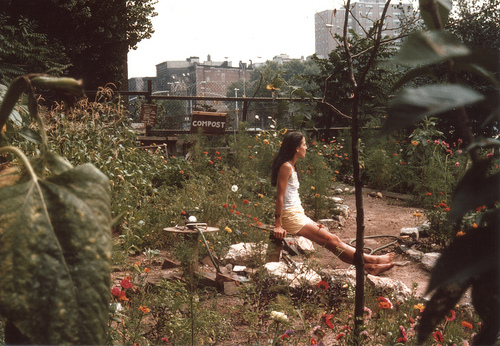Liz Christy and the birth of the Urban Gardening Movement
In the almost 50 years that they have been active, New York’s community gardens have become beloved contributors to city life. Scattered across the 5 boroughs, our community gardens are most densely concentrated in those areas of the city which are or were historically home to New York’s immigrant communities and communities of color: the Lower East Side, the South Bronx, Harlem and East Harlem, and much of North Brooklyn, including Williamsburg, Bushwick, BedStuy, and East New York. It was here, crowded in among the blight and abandonment of the early 1970s, that the GreenThumb movement first took root.
GREEN GUERILLAS
Inasmuch as the GreenThumb program owes its existence to any one person, that person would be activist Liz Christy. A fixture of the Lower East Side of the early 1970s, Christy was a tireless advocate for urban beautification through gardening. As her neighborhood (not to say the city) spiralled into neglect, and the epidemic of vacant buildings and empty lots grew evermore severe, Christy chose to fight back with greenery. Organizing her friends and neighbors into a ragtag gardening group known as the “green guerillas,” Christy began a full frontal attack on the empty lots, derelict homes, and overlooked spaces (thoroughfare medians, cracks in sidewalks) throughout her neighborhood. Her weapon of choice was the “seed green-aid,” a small, cotton-bound nugget of seed and compost lobbed liberally over fences into abandoned spaces throughout the Lower East Side.

These green-aids, together with a healthy sprinkling of sunflower seeds, transformed Christy’s neighborhood even as the city continued to wither. With her tactics literally bearing fruit, Christy soon turned her sights to a greater green: an abandoned patch of land at Bowery and Houston. Where others saw choking weeds, upturned concrete, and eyesore, Christy envisioned a garden. Together with the green guerillas, she petitioned the city to transform this lot into an oasis of green. Her efforts found favor, and on April 23, 1974, the Bowery & Houston “Bowery Houston Community Farm and Garden” was born, the plot of land rented from the city for the nominal price of $1 per month. And with that, New York’s community garden movement was born.

GREEN THUMB
Christy, sadly, succumbed to cancer in 1985. The Bowery-Houston garden, which now bears her name, endures as a testament and model to the urban gardening movement. Moreover, the methodologies she pioneered would soon become enshrined in the city’s GreenThumb program.

Initiated in 1978, and directly inspired by Christy and her Green Guerillas, GreenThumb has grown to become the nation’s largest urban gardening program, with some 20,000 members spread over 600 community gardens in all five boroughs. Part civic agency, part community aggregator, part gardening center, and part educator, GreenThumb collects gardening info, runs interference with various city agencies, distributes simple garden tools and amenities (think, shovels and compost), and hosts over 150 free gardening workshops each year. For anyone interested in joining an urban garden, their interactive garden map is often a helpful first stop.

Christy’s legacy, canonized in GreenThumb’s programming, is more than a simple playbook for urban gardening: It is a shining example of the promise of urban life itself. By providing a small and privileged conduit into the machinery of the city, whereby the voices and desires of individuals and small groups of regular citizens might find a sympathetic ear, GreenThumb helps to amplify and execute the civic desires of communities which have, historically, had some trouble getting their voices heard. And in providing a centralized warehouse of interest, information, and community, GreenThumb connects New Yorkers to plants, neighborhoods, and one another.
The whole thing adds up to an actual hill of beans, growing there alongside the brownstone.
Come and visit GreenThumb’s booth at our upcoming GoGreenBK Festival, this June 2 in McCarren Park, where they will be on hand to answer your questions about urban gardens.



